Baseline Water Temperature: Estimation of the Annual Cycle of Surface Water Temperature in Lakes in North-Central Poland over the 1951–1968 Period
Abstract
1. Introduction
2. Current Research State
2.1. Lake Surface Water Temperature Long-Term Trends
2.2. Variability of Water Temperature in the Yearly and Daily Cycle
2.3. Surface Layer in the Lake
3. Baseline of Water Temperature
3.1. Selection of the Function Best Suited to the Annual Cycle of Water Temperature Change
3.2. Water Temperature Data
3.3. Water Temperature
3.4. Baseline of Water Temperature
3.5. Baseline Or Warm and Cold Years
3.6. Response of Water Temperatures to Climate Changing (Meta-Analysis)
3.7. Limitations of the Proposed Modeling Approach
4. Conclusions
Supplementary Materials
Funding
Acknowledgments
Conflicts of Interest
References
- MacCallum, S.; Merchant, C. Surface water temperature observations of large lakes by optimal estimation. Can. J. Remote Sens. 2012, 38, 25–45. [Google Scholar] [CrossRef]
- Szumiec, M.A. Termika Stawów Karpiowych; Państwowe Wydawnictwo Naukowe: Warszawa, Poland, 1984. [Google Scholar]
- Skowron, R. Water temperature in investigations of Polish lakes. Limnol. Rev. 2017, 17, 31–46. [Google Scholar] [CrossRef]
- Ptak, M. Changes in water temperature and ice phenomena in the Ner River (Central Poland) in the years 1965-2014. Polish J. Sustain. Dev. 2017, 21, 49–56. [Google Scholar] [CrossRef]
- Adrian, R.; Reilly, C.M.O.; Zagarese, H.; Baines, S.B.; Hessen, D.O.; Keller, W.; Livingstone, D.M.; Sommaruga, R.; Straile, D.; Van Donk, E. Lakes as sentinels of climate change. Limnol. Oceanogr. 2009, 54, 2283–2297. [Google Scholar] [CrossRef] [PubMed]
- Richardson, D.C.; Melles, S.J.; Pilla, R.M.; Hetherington, A.L.; Knoll, L.B.; Williamson, C.E.; Kraemer, B.M.; Jackson, J.R.; Long, E.C.; Moore, K.; et al. Transparency, geomorphology and mixing regime explain variability in trends in lake temperature and stratification across Northeastern North America (1975–2014). Water 2017, 9, 442. [Google Scholar] [CrossRef]
- Poff, N.L.; Brinson, M.M.; Day, J.W. Aquatic Ecosystems & Global Climate Change: Potential Impacts on Inland Freshwater and Coastal Wetland Ecosystems in the United States. 2002. Available online: https://www.c2es.org/site/assets/uploads/2002/01/aquatic.pdf (accessed on 6 May 2020).
- Magnuson, J.; Robertson, D.; Benson, B.J.; Wynne, R.; Livingstone, D.M.; Arai, T.; Assel, R.A.; Barry, R.G.; Card, V.M.; Kuusisto, E.; et al. Historical Trends in Lake and River Ice Cover in the Northern Hemisphere. Science 2000, 289, 1743–1746. [Google Scholar] [CrossRef] [PubMed]
- Dobiesz, N.E.; Lester, N.P. Changes in mid-summer water temperature and clarity across the Great Lakes between 1968 and 2002. J. Great Lakes Res. 2009, 35, 371–384. [Google Scholar] [CrossRef]
- Shimoda, Y.; Azim, E.; Perhar, G.; Ramin, M.; Kenney, M.; Sadraddini, S.; Gudimov, A.; Arhonditsis, G. Our current understanding of lake ecosystem response to climate change: What have we really learned from the north temperate deep lakes? Lancet 2011, 37, 173–193. [Google Scholar] [CrossRef]
- O’Reilly, C.M.; Rowley, R.J.; Schneider, P.; Lenters, J.D.; Mcintyre, P.B.; Kraemer, B.M. Rapid and highly variable warming of lake surface waters around the globe. Geophys. Res. Lett. 2015, 42, 1–9. [Google Scholar] [CrossRef]
- Ficker, H.; Luger, M.; Gassner, H. From dimictic to monomictic: Empirical evidence of thermal regime transitions in three deep alpine lakes in Austria induced by climate change. Freshw. Biol. 2017, 62, 1335–1345. [Google Scholar] [CrossRef]
- Rempfer, J.; Livingstone, D.M.; Blodau, C.; Forster, R.; Niederhauser, P.; Kipfer, R. The effect of the exceptionally mild European winter of 2006–2007 on temperature and oxygen profiles in lakes in Switzerland: A foretaste of the future? Limnol. Oceanogr. 2010, 55, 2170–2180. [Google Scholar] [CrossRef]
- Hadley, K.R.; Paterson, A.M.; Stainsby, E.A.; Michelutti, N.; Yao, H.; Rusak, J.A.; Ingram, R.; McConnell, C.; Smol, J.P. Climate warming alters thermal stability but not stratification phenology in a small north-temperate lake. Hydrol. Process 2014, 28, 6309–6319. [Google Scholar] [CrossRef]
- Livingstone, D.M. Impact of secular climate change on the thermal structure of a large Temperate Central European lake. Clim. Chang. 2003, 57, 205–225. [Google Scholar] [CrossRef]
- Woolway, R.I.; Meinson, P.; Nõges, P.; Jones, I.D.; Laas, A. Atmospheric stilling leads to prolonged thermal stratification in a large shallow polymictic lake. Clim. Change 2017, 141, 759–773. [Google Scholar] [CrossRef]
- Schindler, D.W.; Beaty, K.G.; Fee, E.J.; Cruishank, D.R.; DeBruyn, E.D.; Findlay, D.L.; Linsey, G.A.; Shearer, J.A.; Stainton, M.P.; Turner, M.A. Effects of climatic warming on lakes of the central boreal forest. Science 1990, 250, 967–970. [Google Scholar] [CrossRef] [PubMed]
- Robertson, D.M.; Ragotzkie, R.A. Changes in the thermal structure of moderate to large sized lakes in response to changes in air temperature. Aquat. Sci. 1990, 52, 360–380. [Google Scholar] [CrossRef]
- Hondzo, M.; Stefan, H.G. Regional water temperature characteristics of lakes subjected to climate change. Clim. Change 1993, 24, 187–211. [Google Scholar] [CrossRef]
- Stefan, H.G.; Fang, X.; Hondzo, M. Simulated climate change effects on year-round water temperatures in temperate zone lakes. Clim. Change 1998, 40, 547–576. [Google Scholar] [CrossRef]
- Peeters, F.; Livingstone, D.M.; Goudsmit, G.-H.; Kipfer, R.; Forster, R. Modeling 50 years of historical temperature profiles in a large central European lake. Limnol. Oceanogr. 2002, 47, 186–197. [Google Scholar] [CrossRef]
- Skowron, R. Annual cycle of surface water temperature in the lakes in the Polish Lowland and its changeability. In Water Circulation in Natural and Transformed Environment; Michalczyk, Z., Ed.; Badania Hydrograficzne w Poznawaniu Środowiska 8, Wyd; UMCS: Lublin, Poland, 2007; pp. 452–461. [Google Scholar]
- Skowron, R. The Differentiation and the Changeability of Chosen of Elements the Thermal Regime of Water in Lakes on Polish Lowland; Toruń; Wydawnictwo Uniwersytetu M: Kopernika, Poland, 2011; pp. 1–345. [Google Scholar]
- Bergkemper, V.; Weisse, T. Do current European lake monitoring programmes reliably estimate phytoplankton community changes? Hydrobiologia 2018, 824, 143–162. [Google Scholar] [CrossRef]
- Przybylak, R. Change in Poland climate over the last Millennium. Czas. Geogr. 2011, 82, 23–48. [Google Scholar]
- Kożuchowski, K.; Żmudzka, E. The warming in Poland: The range and seasonality of the changes in air temperature in the second half of 20th century. Przegląd Geofiz. 2001, 46, 81–90. [Google Scholar]
- Kożuchowski, K.; Żmudzka, E. Cyrkulacja atmosferyczna i jej wpływ na zmienność temperatury powietrza w Polsce. Przegląd Geogr. 2002, 74, 591–604. [Google Scholar]
- Żmudzka, E. Long-term changes of thermal resources in the vegetative period and the active growth of plants in Poland. Woda-Środowisko-Obszary Wiejskie 2012, 12, 377–389. [Google Scholar]
- Wójcik, R.; Miętus, M. Some features of long-term variability in air temperature in Poland (1951–2010). Przegląd Geogr. 2014, 86, 339–364. [Google Scholar] [CrossRef]
- Graczyk, D.; Pińskwar, I.; Kundzewicz, Z.W.; Hov, Ø.; Førland, E.J.; Szwed, M.; Choryński, A. The heat goes on—changes in indices of hot extremes in Poland. Theor. Appl. Climatol. 2016, 110, 103–113. [Google Scholar] [CrossRef][Green Version]
- Marosz, M.; Wójcik, R.; Biernacik, D.; Jakusik, E.; Pilarski, M.; Owczarek, M.; Miętus, M. Zmienność klimatu Polski od połowy XX wieku. Prace i Studia Geogr. 2011, 47, 51–66. [Google Scholar]
- Ptak, M.; Sojka, M.; Choiński, A.; Nowak, B. Effect of environmental conditions and morphometric parameters on surface water temperature in Polish Lakes. Water 2018, 10, 580. [Google Scholar] [CrossRef]
- Skowron, R. Water temperature in the lakes of Northern Poland during the bathing season. Bull. Geogr. Phys. Geogr. Ser. 2018, 15, 75–90. [Google Scholar] [CrossRef]
- Sobolewski, W.; Borowiak, D.; Borowiak, M.; Skowron, R. Baza Danych Jezior Polski i jej Wykorzystanie w Badaniach Limnologicznych. PICADOR Komunikacja Graficzna s.c. Lublin. 2014. Available online: https://kl.ug.edu.pl/download/BDJP.pdf (accessed on 17 April 2019).
- Skowron, R.; Piasecki, A. Dynamics of the daily course of water temperature in Polish lakes. J. Water Land Dev. 2016, 31, 149–156. [Google Scholar] [CrossRef]
- Koczorowska, R. The impact of a fuel-energy complex on selected elements of water balance. Probl. Ekologii Kraj. 2001, 10, 158–163. [Google Scholar]
- Pasławski, Z. Stosunki termiczne i wodne Jeziora Pątnowskiego. Gospod. Wodna 1967, 27, 117–122. [Google Scholar]
- Zdanowski, B. Wpływ zrzutu wód podgrzanych na stosunki termiczno-tlenowe i przezroczystość wody jezior konińskich. Roczniki Nauk Rol. 1976, 97-H-3, 141–162. [Google Scholar]
- Magee, M.R.; Wu, C.H. Response of water temperatures and stratification to changing climate in three lakes with different morphometry. Hydrol. Earth Syst. Sci. 2017, 21, 6253–6274. [Google Scholar] [CrossRef]
- Imberger, J.; Patterson, J.C. Physical Limnology. In Advances in Applied Mechanics; Hutchinson, J.W., Wu, T.Y., Eds.; Elsevier: Amsterdam, The Netherlands, 1989; Volume 27, pp. 303–475. [Google Scholar]
- Boehrer, B.; Schultze, M. Stratification of lakes. Rev. Geophys. 2008, 46, L16405. [Google Scholar] [CrossRef]
- Edinger, J.E.; Duttweiler, D.W.; Geyer, J.C. The response of water temperatures to meteorological conditions. Water Resour. Res. 1968, 4, 1137–1144. [Google Scholar] [CrossRef]
- Kettle, H.; Thompson, R.; Anderson, N.J.; Livingstone, D.M. Empirical modeling of summer lake surface temperatures in southwest Greenland. Limnol. Oceanogr. 2004, 49, 271–282. [Google Scholar] [CrossRef]
- Hampton, S.E.; Izmest’eva, L.R.; Moore, M.V.; Katz, S.L.; Dennis, B.; Silow, E.A. Sixty years of environmental change in the world’s largest freshwater Lake–Lake Baikal, Siberia. Glob. Chang. Biol. 2008, 14, 1947–1958. [Google Scholar] [CrossRef]
- Coats, R.; Perez-Losada, J.; Schladow, G.; Richards, R.; Goldman, C. The warming of Lake Tahoe. Clim. Chang. 2006, 76, 121–148. [Google Scholar] [CrossRef]
- Straile, D.; Joehnk, K.; Rossknecht, H. Complex effects of winter warming on the physico-chemical characteristics of a deep lake. Limnol. Oceanogr. 2003, 48, 1432–1438. [Google Scholar] [CrossRef]
- Apsite, E.; Elferts, D.; Zubaničs, A.; Latkovska, I. Long-term changes in hydrological regime of the lakes in Latvia. Hydrol. Res. 2014, 45, 308–321. [Google Scholar] [CrossRef]
- Dąbrowski, M.; Marszelewski, W.; Skowron, R. The trends and dependencies between air and water temperatures in lakes in northern Poland from 1961–2000. Hydrol. Earth Syst. Sci. Discuss. Eur. Geosci. Union 2004, 8, 79–87. [Google Scholar] [CrossRef]
- Austin, J.A.; Colman, S.M. A century of temperature variability in Lake Superior. Limnol. Oceanogr. Methods 2008, 53, 2724–2730. [Google Scholar] [CrossRef]
- Arvola, L.; George, G.; Livingstone, D.M.; Järvinen, M.; Blenckner, T.; Dokulil, M.T.; Jennings, E.; Aonghusa, C.N.; Nõges, P.; Nõges, T.; et al. The impact of the changing climate on the thermal characteristics of lakes. In The Impact of Climate Change on European Lakes; George, D.G., Ed.; Aquatic Ecology Series; Springer: Dordrecht, The Netherlands, 2009; pp. 65–101. [Google Scholar] [CrossRef]
- Mooij, W.M.; De Senerpont Domis, L.N.; Hülsmann, S. The impact of climate warming on water temperature, timing of hatching and young-of-the-year growth of fish in shallow lakes in the Netherlands. J. Sea Res. 2008, 60, 32–43. [Google Scholar] [CrossRef]
- Marszelewski, W.; Pius, B. Effect of climate change on thermal-ice regime of shallow lakes compared to deep lakes: Case study of lakes in the temperate zone (Northern Poland). J. Limnol. 2019, 78, 27–39. [Google Scholar] [CrossRef]
- Arhonditsis, G.B.; Brett, M.T.; DeGasperi, C.L.; Schindler, D.E. Effects of climatic variability on the thermal properties of Lake Washington. Limnol. Oceanogr. 2004, 49, 256–270. [Google Scholar] [CrossRef]
- Niedrist, G.H.; Psenner, R.; Sommaruga, R. Climate warming increases vertical and seasonal water temperature differences and inter-annual variability in a mountain lake. Clim. Chang. 2018, 151, 473–490. [Google Scholar] [CrossRef]
- Chojnowski, S. Preliminary characteristics of thermal phenomena in the Konin Lakes. Prace Państwowego Inst. Hydrol. Meteorol. 1972, 107, 99–117. [Google Scholar]
- Davies-Colley, R.J. Mixing depths in New Zealand lakes. New Zealand J. Mar. Freshw. Res. 1988, 22, 517–528. [Google Scholar] [CrossRef][Green Version]
- Patalas, K. Stosunki termiczne i tlenowe oraz przezroczystość wody w 44 jeziorach okolic Węgorzewa. Roczn Nauk Rol. B 1960, 77, 105–222. [Google Scholar]
- Skowron, R. Struktura termiczna wody w okresie letniej stagnacji na przykładzie wybranych jezior z Pojezierza Gnieźnieńskiego i Kujawskiego. Acta Univ. Nicolai Copernici. Geogr. 1990, 22, 45–83. [Google Scholar]
- Jańczak, J.; Maślanka, W. Cases of occurrence of secondary metalimnia in some lakes of the Ełk Lakeland. Limnol. Rev. 2006, 6, 123–128. [Google Scholar]
- Maślanka, W.; Nowiński, K. Diversity of development of summer thermocline layers in Lake Upper Raduńskie. Limnol. Rev. 2006, 6, 201–206. [Google Scholar]
- Januszkiewicz, T. Przyczynek do znajomości chemizmu jeziora Ewingi. Pol. Arch. Hydrobiol. 1965, 13, 63–88. [Google Scholar]
- Skowron, R. Zmiany temperatury wody i zasobów ciepła w przebiegu dobowym na przykładzie epitermicznego jeziora Gopło. Acta Univ. Nicolai Copernici. Geogr. 2000, 31, 289–306. [Google Scholar]
- Kondracki, J. Obserwacje nad termiką jeziora Niegocin na stacji naukowej Polskiego Towarzystwa Geograficznego w Giżycku (1949-1951). Przegl. Geogr. 1952, 24, 49–71. [Google Scholar]
- TableCurve (Curve Fitting Software); Version 3.11; Manual; Systat Software: San Jose, CA, USA, 1992.
- Choiński, A. Katalog jezior Polski; Wydawnictwo Naukowe UAM: Poznań, Poland, 2006. [Google Scholar]
- Komsta, L. Rewizja matematyczna siatki geobotanicznej ATPOL-propozycja algorytmów konwersji współrzędnych. Ann. UMCS Sectio E Agric. 2016, 71, 31–37. [Google Scholar]
- Verey, M. Teoretyczna analiza i praktyczne konsekwencje przyjęcia modelowej siatki ATPOL jako odwzorowania stożkowego definiującegokonwersję współrzędnych płaskich na elipsoidę WGS 84. Fragm. Florist. Geobot. Polon. 2017, 24, 469–488. [Google Scholar]
- Olszewski, P. Obserwacje chemiczne z jeziora Tajty. Roczn. Nauk Roln. 1953, 67, 23–65. [Google Scholar]
- Walczak, J. Sielawa (Coregonus albula L.) kilku jezior Pomorza Zachodniego. Roczn. Nauk Rol. 1953, 67, 21–37. [Google Scholar]
- Walczak, J. Przemieszanie i rozpraszanie się stada sielawowego w jeziorze Charzykowo. Roczn. Nauk Rol. 1953, 67, 39–51. [Google Scholar]
- Spodniewska, I. The plankton of Lake Tajty. Ekol. Polska 1955, 3, 181–228. [Google Scholar]
- Olszewski, P.; Paschalski, J. Wstępna charakterystyka limnologiczna niektórych jezior Pojezierza Mazurskiego. Zesz. Nauk. WSR w Olszt. 1959, 4, 1–109. [Google Scholar]
- Szmal, Z. Badania hydrochemiczne jezior lobeliowych Pomorza Zachodniego. PTPN Wydz. Mat. Przyr. Prace Kom. Biol. 1959, 19, 1–107. [Google Scholar]
- Olszewski, P.; Tadajewski, A.; Lossow, K.; Więcławski, F. Wstępna charakterystyka limnologiczna niektórych jezior Pojezierza Mazurskiego. Cz. II. Zesz. Nauk. Akad. Rol. Tech. w Olsztynie. Ochrona Wód i Ryb Śród. 1978, 7, 3–80. [Google Scholar]
- Dokulil, M.T.; Jagsch, A.; George, G.D.; Anneville, O.; Jankowski, T.; Wahl, B.; Lenhart, B.; Blenckner, T.; Teubner, K. Twenty years of spatially coherent deepwater warming in lakes across Europe related to the North Atlantic Oscillation. Limnol. Oceanogr. 2006, 51, 2787–2793. [Google Scholar] [CrossRef]
- Winslow, L.A.; Read, J.S.; Hansen, G.J.A.; Hanson, P.C. Small lakes show muted climate change signal in deepwater temperatures. Geophys. Res. Lett. 2015, 42, 355–361. [Google Scholar] [CrossRef]
- Dokulil, M.T.; Teubner, K.; Jagsch, A. Climate change affecting hypolimnetic water temperatures in deep alpine lakes. Verh. Internat. Verein Limnol. 2006, 29, 1285–1288. [Google Scholar] [CrossRef]
- Kraemer, B.M.; Anneville, O.; Chandra, S.; Dix, M.; Kuusisto, E.; Livingstone, D.M.; Rimmer, A.; Schladow, S.G.; Silow, E.; Sitoki, L.M.; et al. Morphometry and average temperature affect lake stratification responses to climate change. Geophys. Res. Lett. 2015, 42, 4981–4988. [Google Scholar] [CrossRef]
- Paluch, J.; Małecki, Z.J.; Gołebiak, P. Wpływ zbiornika zaporowego Gołuchów na mikroklimat w zlewni Ciemnej (Trzemnej), lewobrzeżnym dopływie Prosny. Zeszyty Naukowe Inżynieria Lądowa i Wodna w Kształtowaniu Środowiska 2009, 1, 26–34. [Google Scholar]
- Ptak, M.; Nowak, B. Warunki termiczno-tlenowe Jeziora Białego Włodawskiego w półroczu letnim (2012–2015. Ann. Univ. Mariaecurie Skłodowska Lublin Polonia 2016, 71, 61–71. [Google Scholar] [CrossRef]
- Prats, J.; Danis, P.A. An epilimnion and hypolimnion temperature model based on air temperature and lake characteristics. Knowl. Manag. Aquat. Ecosyst. 2019, 420, 8. [Google Scholar] [CrossRef]
- Marszelewski, W.; Skowron, R. Extreme ice phenomena on the lakes of Northern Poland. Limnol. Rev. 2009, 9, 81–89. [Google Scholar]
- Layden, A.; Merchant, C.; MacCallum, S. Global climatology of surface water temperatures of large lakes by remote sensing. Int. J. Climatol. 2015, 35, 4464–4479. [Google Scholar] [CrossRef]
- Lieberherr, G.; Wunderle, S. Lake Surface Water Temperature Derived from 35 Years of AVHRR Sensor Data for European Lakes. Remote Sens. 2018, 10, 990. [Google Scholar] [CrossRef]
- Najberek, K.; Solarz, W. Konin Lakes as a hot spot for biological invasions in Poland. In Alien Species in the Fauna of Poland; Głowaciński, Z., Okarma, H., Pawłowski, J., Solarz, W., Eds.; Instytut Ochrony Przyrody PAN: Kraków, Poland, 2011; pp. 614–623. [Google Scholar]
- Kraska, M. Reactions of Lake Ecosystem on Heated Waters, with Special Regard to Hydromacrophytes; Wydawnictwo Naukowe UAM: Poznań, Poland, 1988. [Google Scholar]
- Sosnowska, J. Effect of heated effluents on the phytoplankton in some lakes near Konin. Rocz. Nauk Rol. 1988, Ser H 101, 9–130. [Google Scholar]
- Robson, B.J. When do aquatic systems models provide useful predictions, what is changing, and what is next? Environ. Modell. Softw. 2014, 61, 287–296. [Google Scholar] [CrossRef]
- Chang, M.Q.; Teurlincx, S.; DeAngelis, D.L.; Janse, J.H.; Troost, T.A.; Van Wijk, D.; Mooij, W.M.; Janssen, A.B.G. A Generically Parameterized model of Lake eutrophication (GPLake) that linksfield-, lab- and model-based knowledge. Sci. Total. Environ. 2019, 695, 13388. [Google Scholar] [CrossRef]
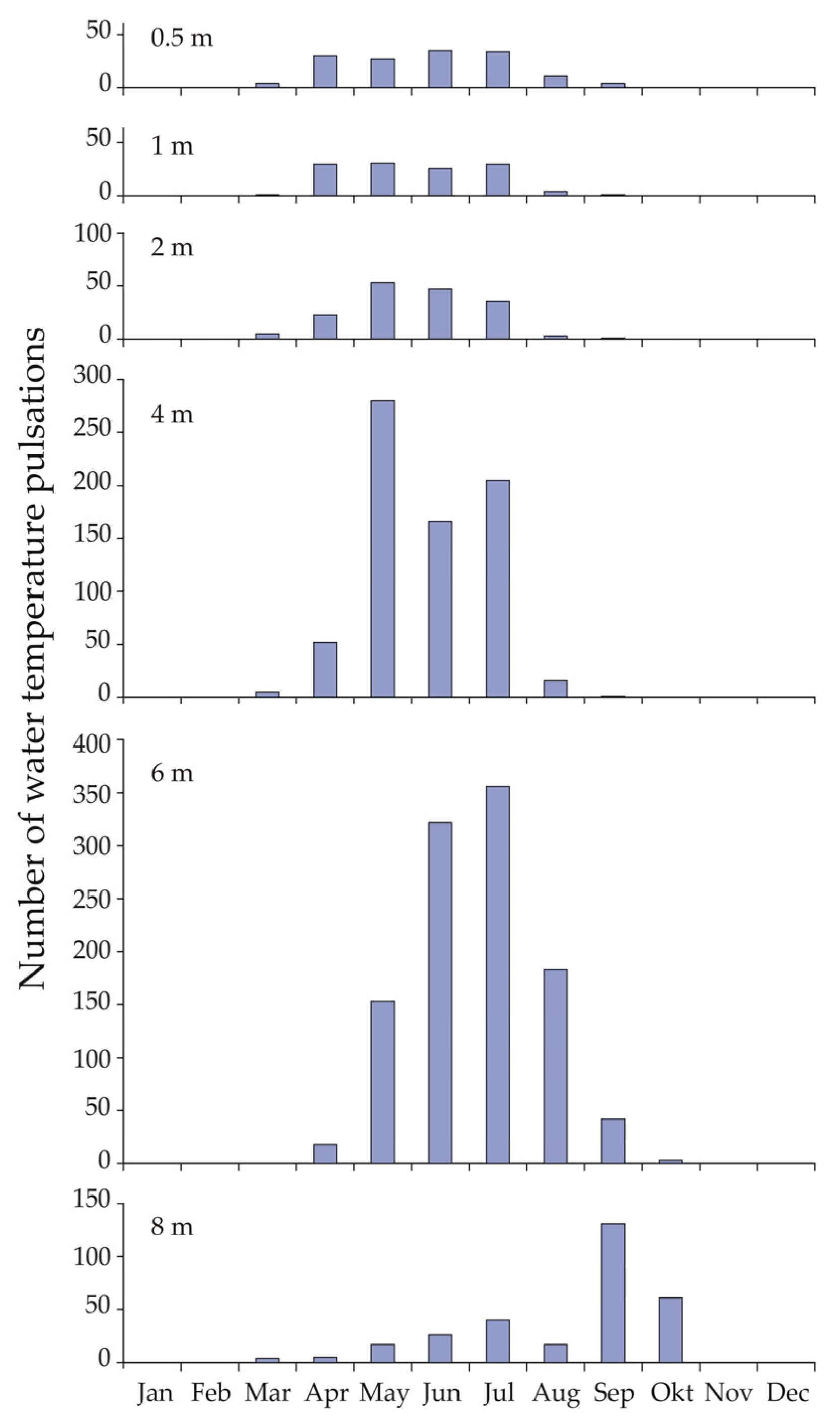
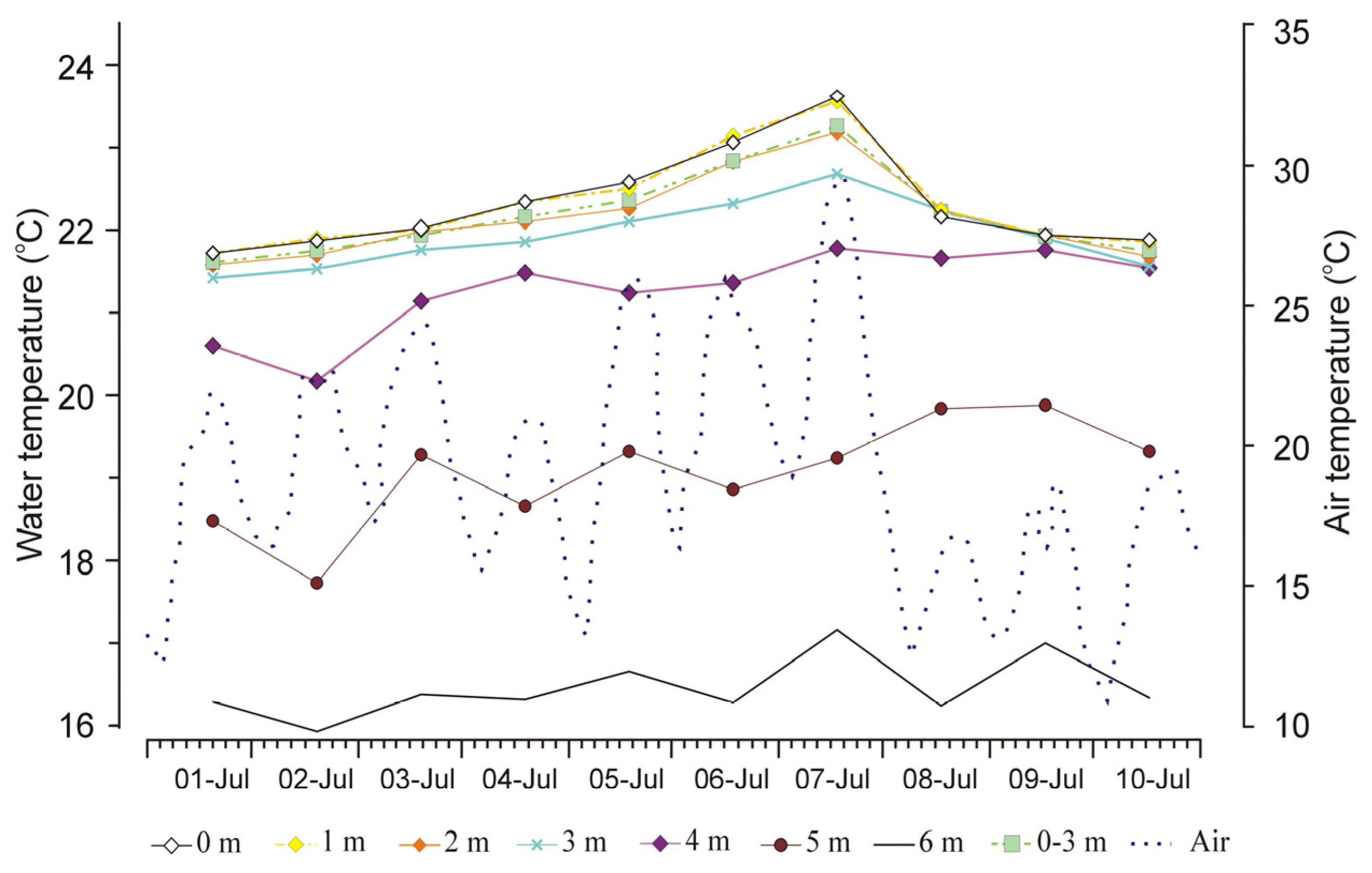
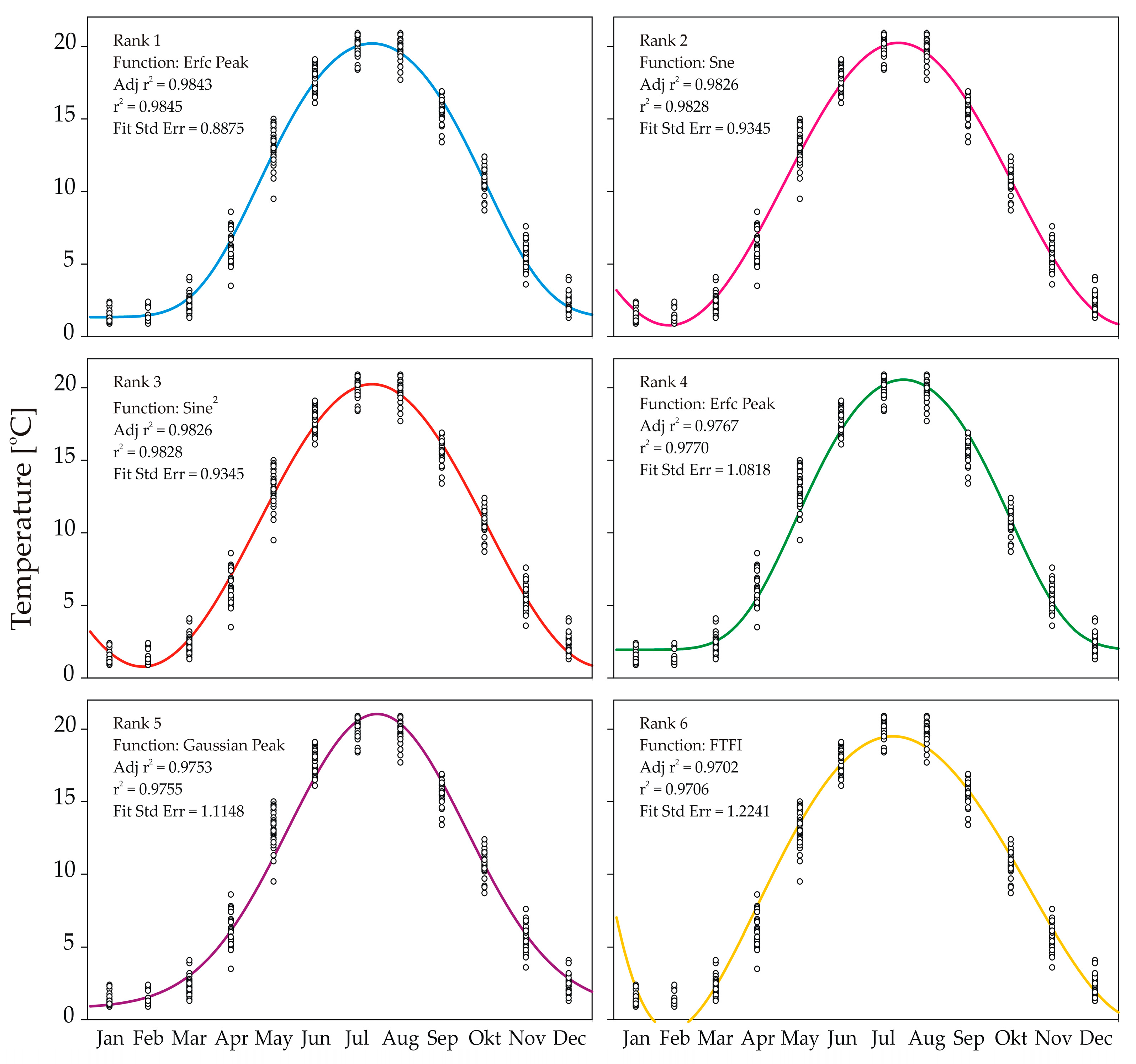
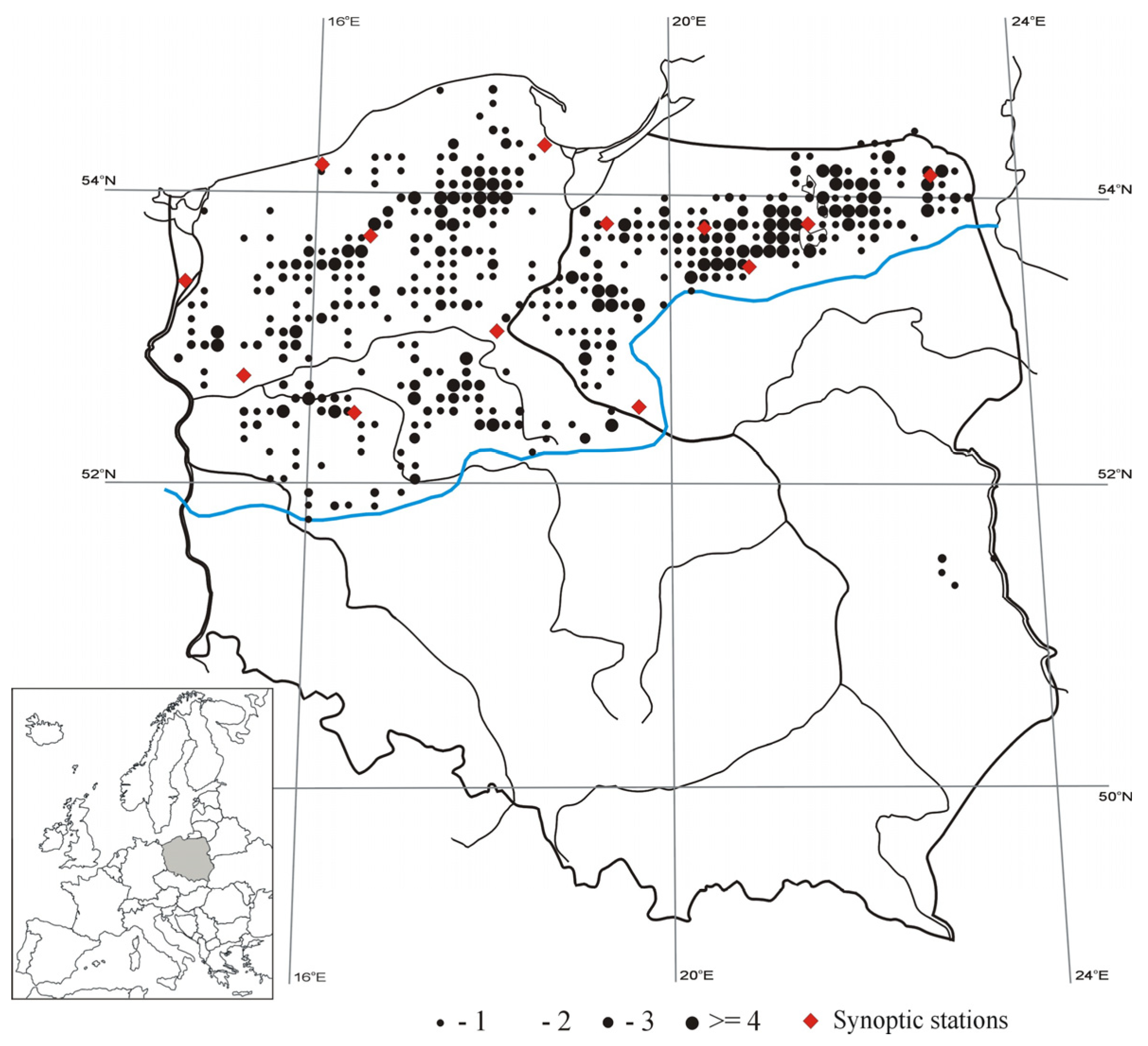
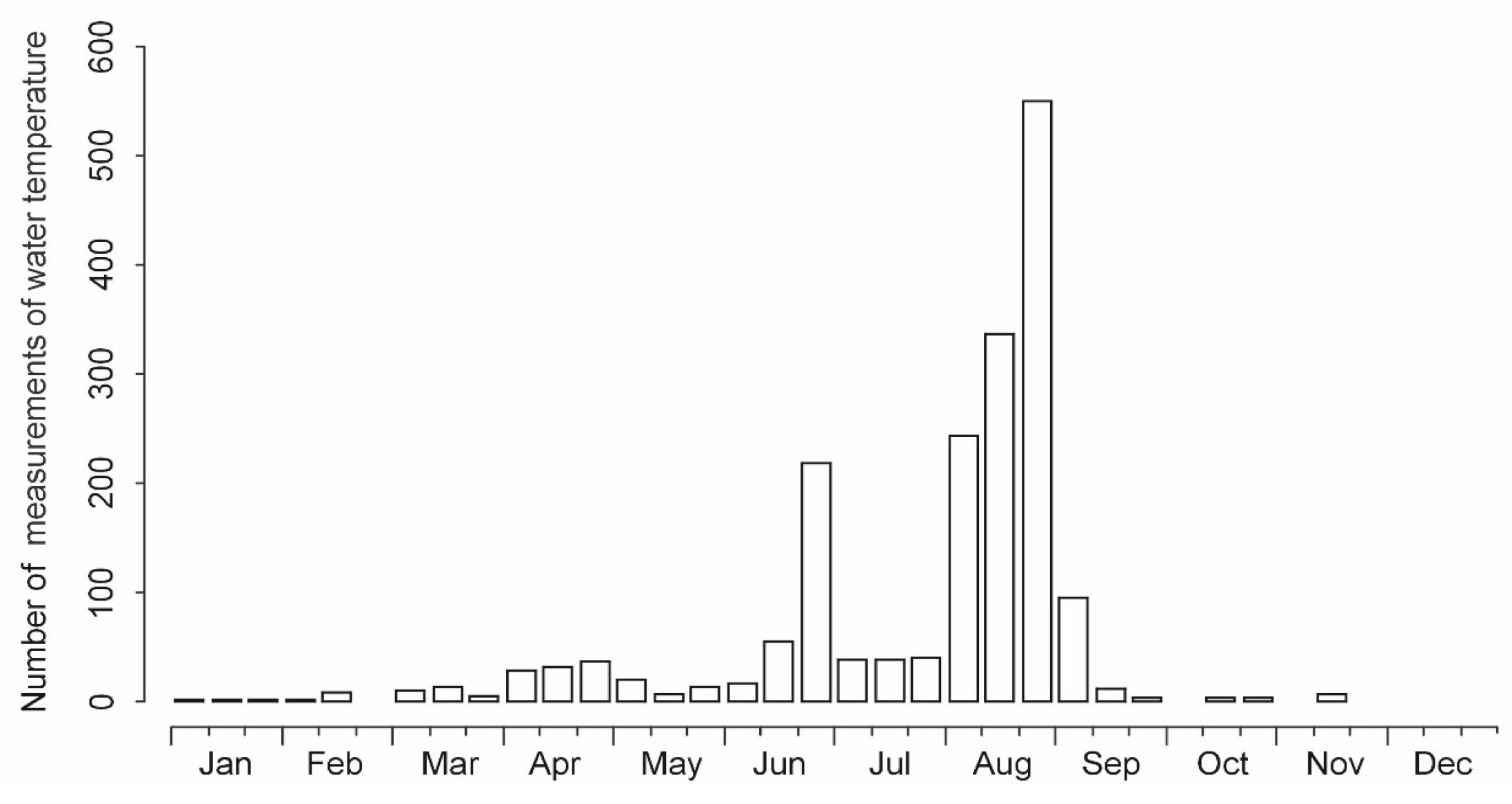
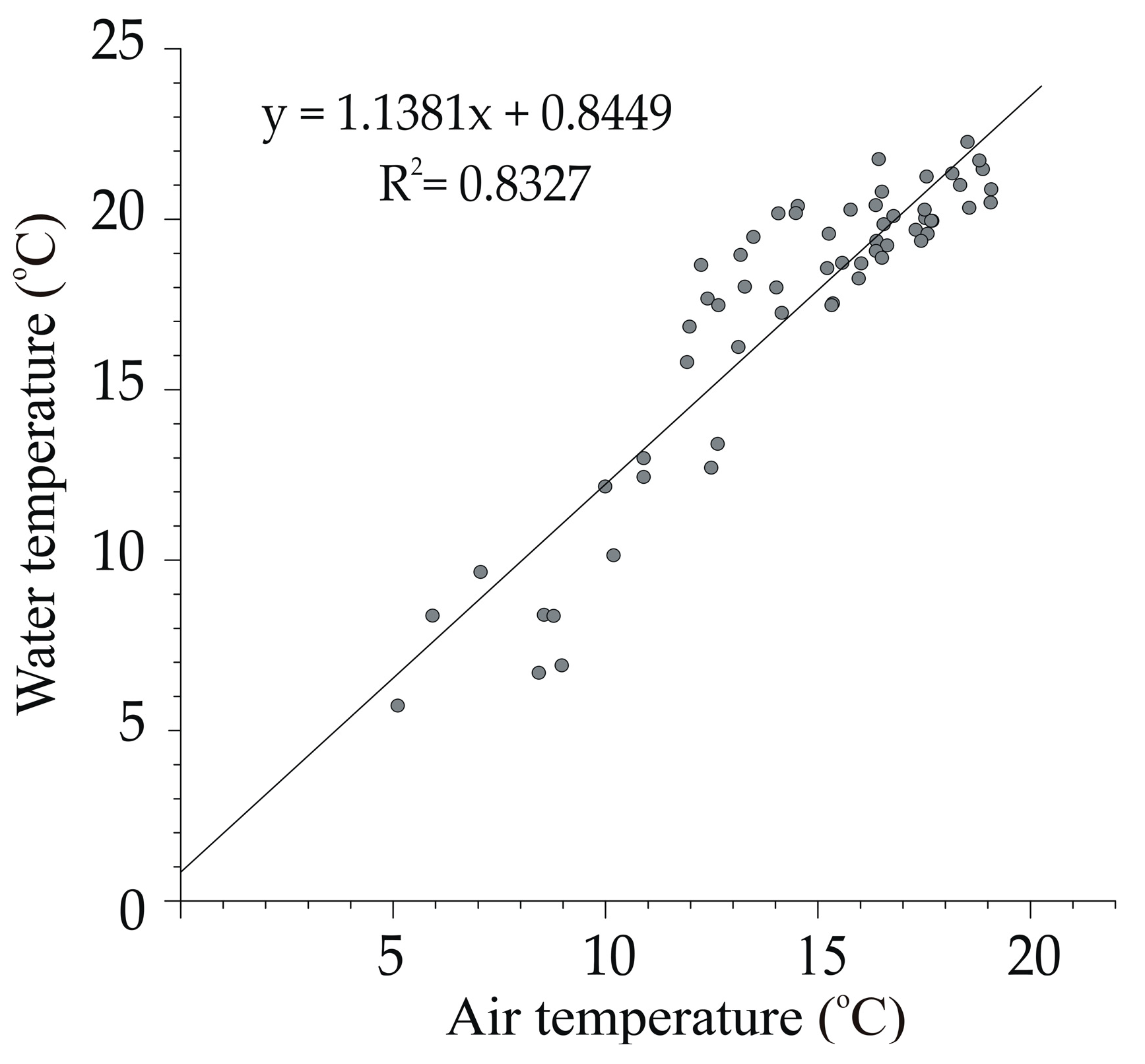

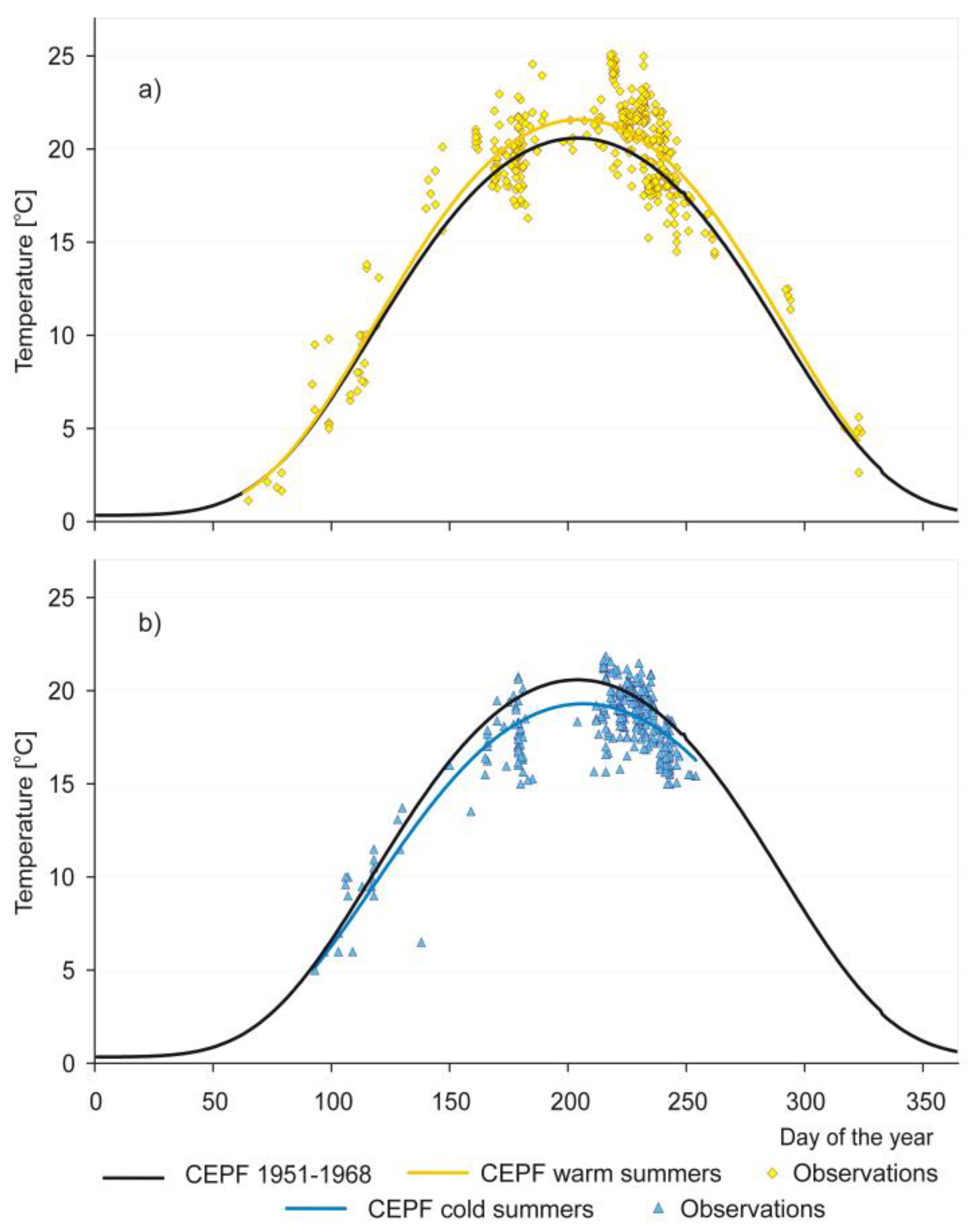
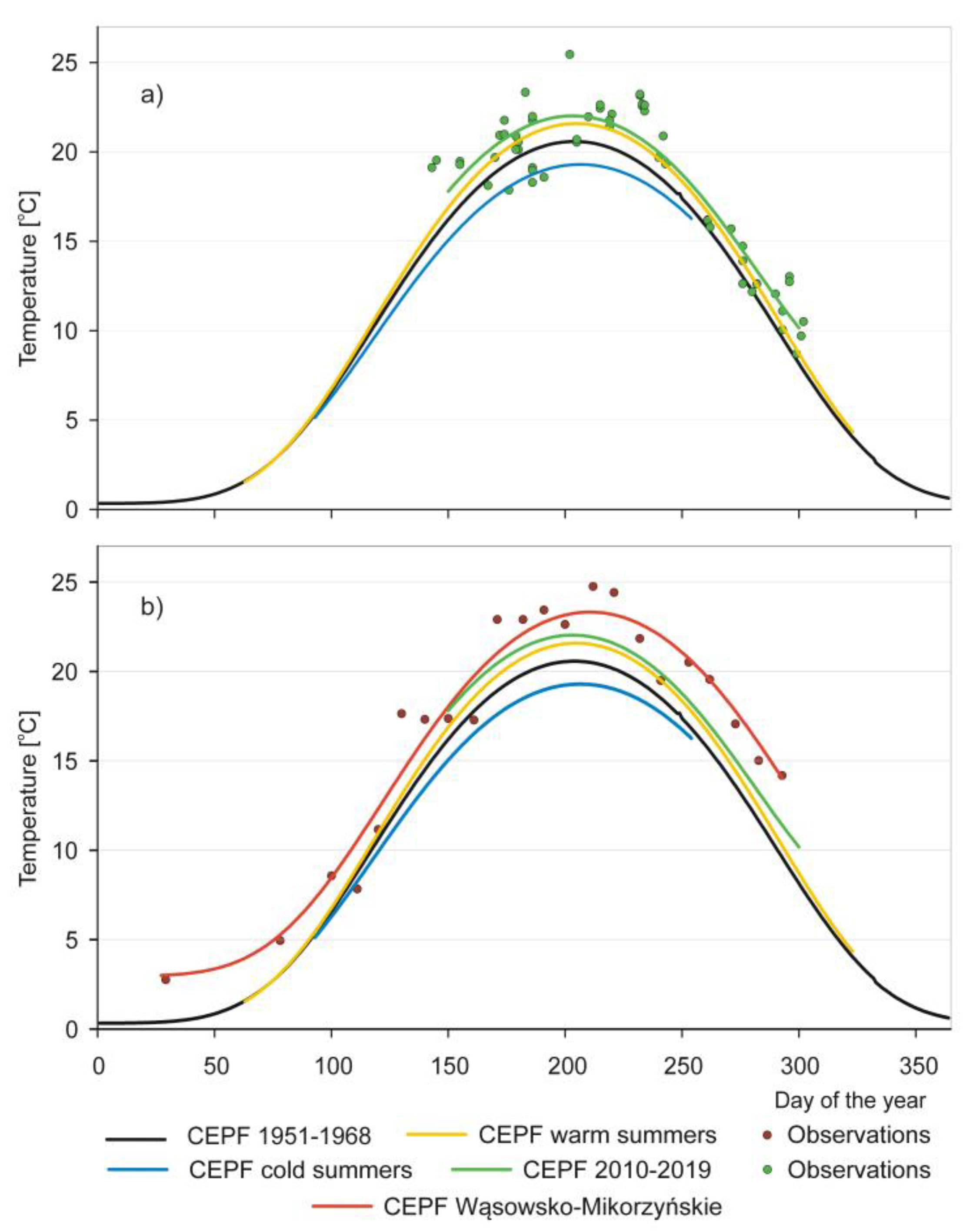
| Citation | Type | Location | LSWT Trends (°C Decade−1) | Years |
|---|---|---|---|---|
| [49] | IS (1) | SL: L. Superior | 0.27 a | 1906–2005 |
| [15] | IS (1) | SL: L. Zurich (CH) | 0.41 b | 1947–1998 |
| [50] | IS (4) | R: UK | 0.35 c (0.30–0.39) c | 1960–2000 |
| [50] | IS (4) | R: Austria | 0.43 c (0.17–0.54) c | 1961–2000 |
| [51] | IS (3) | R: Holand | 0.42 d | 1961–2005 |
| [52] | IS (2) | SL: L. Łebsko (PL) SL: L. Charzykowskie (PL) | 0.26 e 0.25 e | 1961–2015 |
| [53] | IS (1) | SL: L. Washington (U.S.) | 0.45 f | 1964−1998 |
| [6] | IS (85) IS (226) | R: northeastern North America | 0.54 g 0.52 g | 1975–2014 1985–2014 |
| [54] | IS (1) | SL: Piburgersee (A) | ~0.36 h 0.65 h 0.10 h | 1972–2015 1972−1993 1993–2015 |
| [32] | IS (14) | R: Poland | 0.43 i (0.32–0.64) i | 1972–2016 |
| [11] | IS (118) SAT (128) | Global | 0.34 j (–0.7–1.3) j | 1985–2009 |
| Citation | Lake Name/ Number of Lakes | June | July | August | September | Years |
|---|---|---|---|---|---|---|
| [48] | L. Jeziorak | 0.00 | 0.24 | 0.56 | 0.14 | 1961–2000 |
| L. Mikołajskie | −0.02 | 0.09 | 0.21 | −0.11 | ||
| L. Hańcza | 0.29 | 0.21 | 0.38 | −0.04 | ||
| L. Studzieniczne | 0.15 | 0.09 | 0.24 | −0.29 | ||
| [34] | 28 | 0.39 | 0.58 | 0.48 | 0.39 | 1971–2010 |
| (0.2–0.8) | (0.4–1.0) | (0.2–0.9) | (0.1–0.7) | |||
| L. Jeziorak | 0.2 | 0.6 | 0.6 | 0.6 | ||
| L. Mikołajskie | 0.3 | 0.6 | 0.5 | 0.4 | ||
| L. Hańcza | 0.7 | 0.6 | 0.4 | 0.2 | ||
| L. Studzieniczne | 0.2 | 0.6 | 0.4 | 0.3 | ||
| [32] | 14 | (0.2–0.8) | (0.4–0.8) | (0.4–0.6) | (0.1-0.7) | 1972–2016 |
| Rank | t Coefficient | Correlation Coefficient | p Value | |
|---|---|---|---|---|
| 1 | CEFP | 64.59 | 0.99880 | <0.001 |
| 2 | Sine | 50.32 | 0.99803 | <0.001 |
| 3 | Sine2 | 50.32 | 0.99803 | <0.001 |
| 4 | CEFP 2 | 30.20 | 0.99456 | <0.001 |
| 5 | Gaussian | 29.00 | 0.99411 | <0.001 |
| 6 | FTFI | 24.60 | 0.99184 | <0.001 |
| Citation | Number of Lakes | June | July | August | September | Years |
|---|---|---|---|---|---|---|
| This study | 10 | 0.24 | 0.29 | 0.30 | 0.26 | 1951–1968/2010–2019 |
Publisher’s Note: MDPI stays neutral with regard to jurisdictional claims in published maps and institutional affiliations. |
© 2020 by the author. Licensee MDPI, Basel, Switzerland. This article is an open access article distributed under the terms and conditions of the Creative Commons Attribution (CC BY) license (http://creativecommons.org/licenses/by/4.0/).
Share and Cite
Hutorowicz, A. Baseline Water Temperature: Estimation of the Annual Cycle of Surface Water Temperature in Lakes in North-Central Poland over the 1951–1968 Period. Water 2020, 12, 3574. https://doi.org/10.3390/w12123574
Hutorowicz A. Baseline Water Temperature: Estimation of the Annual Cycle of Surface Water Temperature in Lakes in North-Central Poland over the 1951–1968 Period. Water. 2020; 12(12):3574. https://doi.org/10.3390/w12123574
Chicago/Turabian StyleHutorowicz, Andrzej. 2020. "Baseline Water Temperature: Estimation of the Annual Cycle of Surface Water Temperature in Lakes in North-Central Poland over the 1951–1968 Period" Water 12, no. 12: 3574. https://doi.org/10.3390/w12123574
APA StyleHutorowicz, A. (2020). Baseline Water Temperature: Estimation of the Annual Cycle of Surface Water Temperature in Lakes in North-Central Poland over the 1951–1968 Period. Water, 12(12), 3574. https://doi.org/10.3390/w12123574





